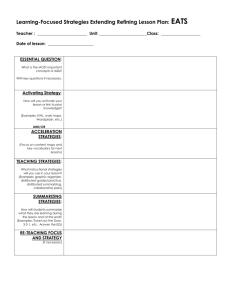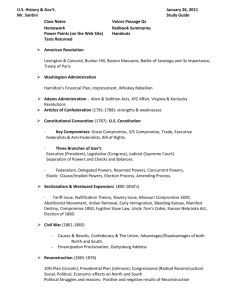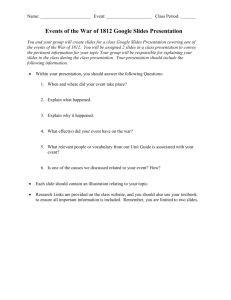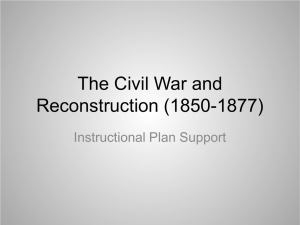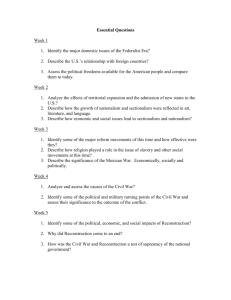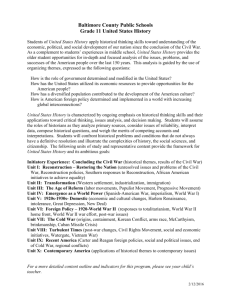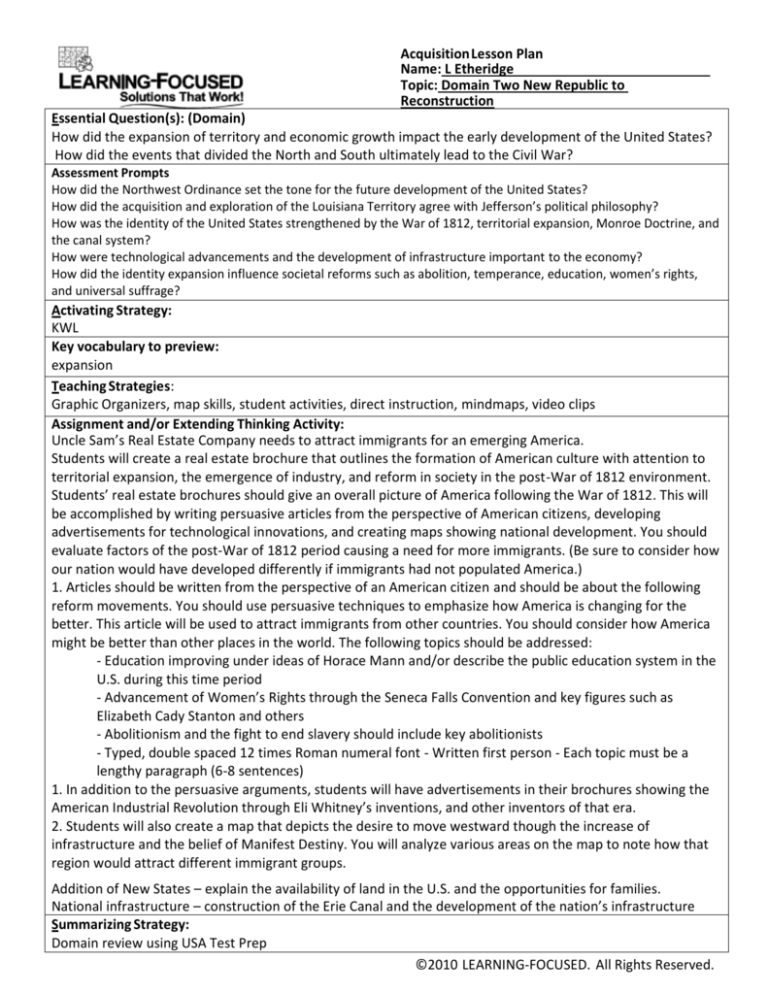
Acquisition Lesson Plan
Name: L Etheridge
Topic: Domain Two New Republic to
Reconstruction
Essential Question(s): (Domain)
How did the expansion of territory and economic growth impact the early development of the United States?
How did the events that divided the North and South ultimately lead to the Civil War?
Assessment Prompts
How did the Northwest Ordinance set the tone for the future development of the United States?
How did the acquisition and exploration of the Louisiana Territory agree with Jefferson’s political philosophy?
How was the identity of the United States strengthened by the War of 1812, territorial expansion, Monroe Doctrine, and
the canal system?
How were technological advancements and the development of infrastructure important to the economy?
How did the identity expansion influence societal reforms such as abolition, temperance, education, women’s rights,
and universal suffrage?
Activating Strategy:
KWL
Key vocabulary to preview:
expansion
Teaching Strategies:
Graphic Organizers, map skills, student activities, direct instruction, mindmaps, video clips
Assignment and/or Extending Thinking Activity:
Uncle Sam’s Real Estate Company needs to attract immigrants for an emerging America.
Students will create a real estate brochure that outlines the formation of American culture with attention to
territorial expansion, the emergence of industry, and reform in society in the post-War of 1812 environment.
Students’ real estate brochures should give an overall picture of America following the War of 1812. This will
be accomplished by writing persuasive articles from the perspective of American citizens, developing
advertisements for technological innovations, and creating maps showing national development. You should
evaluate factors of the post-War of 1812 period causing a need for more immigrants. (Be sure to consider how
our nation would have developed differently if immigrants had not populated America.)
1. Articles should be written from the perspective of an American citizen and should be about the following
reform movements. You should use persuasive techniques to emphasize how America is changing for the
better. This article will be used to attract immigrants from other countries. You should consider how America
might be better than other places in the world. The following topics should be addressed:
- Education improving under ideas of Horace Mann and/or describe the public education system in the
U.S. during this time period
- Advancement of Women’s Rights through the Seneca Falls Convention and key figures such as
Elizabeth Cady Stanton and others
- Abolitionism and the fight to end slavery should include key abolitionists
- Typed, double spaced 12 times Roman numeral font - Written first person - Each topic must be a
lengthy paragraph (6-8 sentences)
1. In addition to the persuasive arguments, students will have advertisements in their brochures showing the
American Industrial Revolution through Eli Whitney’s inventions, and other inventors of that era.
2. Students will also create a map that depicts the desire to move westward though the increase of
infrastructure and the belief of Manifest Destiny. You will analyze various areas on the map to note how that
region would attract different immigrant groups.
Addition of New States – explain the availability of land in the U.S. and the opportunities for families.
National infrastructure – construction of the Erie Canal and the development of the nation’s infrastructure
Summarizing Strategy:
Domain review using USA Test Prep
©2010 LEARNING-FOCUSED. All Rights Reserved.
Acquisition Lesson Pacing Guide
Name: L Etheridge
Topic: Domain Two – New Republic to Reconstruction
Day 17/Session 1
Day 18/Session 2
Day 19/Session 3
Essential Question:
How did Northwest Ordinance and
policies of the Jefferson
administration lead to the
expansion of the U.S.?
How did the Louisiana Purchase
double the size of the United
States?
How did the Lewis and Clark
expedition increase settlement in
newly acquire land the frontier.
Essential Question:
How was the identity of the United
States strengthened by the War of
1812, territorial expansion,
Monroe Doctrine, and the canal
system?
Essential Question:
How did the growth of cities and
industry in the Northeast lead to
the growth of infrastructure.
How did the Industrial Revolution
led to an increase in slavery and
immigration
Activating Strategy:
Daily 10
List the first 5 presidents of the US
in order
Activating Strategy:
Daily 10
Show video clip of Erie canal to
the tune of the Eire Canal by
Bruce Springsteen.
Activating Strategy:
Daily 10
Key Vocabulary and Strategy:
Louisiana Purchase
Northwest Ordinance
Key Vocabulary and Strategy:
Erie Canal
infrastructure
Students define each term in their Monroe Doctrine
notebooks using column method. War of 1812
Students define each term in their
Thomas Jefferson
notebooks using column method.
Lewis and Clark
Key Vocabulary and Strategy:
cotton gin
Industrial Revolution
sectionalism
Using Important Person sheet –
write about historical figures
Using Important Person sheet –
write about historical figures
Students define each term in their
notebooks using column method.
Eli Whitney
Teaching Strategies:
Teaching Strategies:
Teaching Strategies:
Read and discuss pages 73-75 Read and discuss pages 79-80
Read and discuss pages 69-72
in Workbook
in workbook
in workbook
Student fill in
Cause of the War of 1812
School house Rock “Elbow
Students in small groups will
graphic organizer
Room”
create an editorial trumpeting
View video clip on Monroe
Mapping of Northwest
the influence of new
Doctrine
Ordinance, Louisiana Purchase
technology such as
and westward expansion and
Students will create a
interchangeable parts and the
Lewis and Clark Expedition
newspaper advertisement for
invention of the cotton gin by
or
against
the
War
of
1812
or
Mind map of Westward
Eli Whitney or refute such
and advertisement for the
expansion
inventions as a negative impact
Monroe Doctrine.
on society
Video clip of Madison’s
presidency
Assessment Prompt :
Assessment Prompt : How did the Assessment Prompt :
How were technological
Northwest Ordinance set the tone How was the identity of the United
States
strengthened
by
the
War
of
advancements and the development
for the future development of the
1812, territorial expansion, Monroe
of infrastructure important to the
United States?
Doctrine, and the canal system?
economy?
How did the acquisition and
exploration of the Louisiana
Territory agree with Jefferson’s
political philosophy?
Summarizing Strategy:
Summarizing Strategy:
Summarizing Strategy:
Create a twitter feed chronicling
Answer assessment prompt on
Answer assessment prompt on left
either Jefferson’s purchase of LA or left side of notes
side of notes
the Lewis and Clark expedition17
©2010 LEARNING-FOCUSED. All Rights Reserved.
Day 20/Session 4
Essential Question:
How did the accumulation of new
territory affect sectionalism?
Activating Strategy:
Daily 10
Key Vocabulary and Strategy:
Gadsden Purchase
Manifest Destiny
War with Mexico
Students define each term in
their notebooks using column
method
Day 21/Session 5
Essential Question:
How did Andrew Jackson’s
presidency lead to social and
political reform?
Activating Strategy:
Daily 10
Key Vocabulary and Strategy:
Indian removal
Jacksonian Democracy
Trail of Tears
two party system
universal suffrage
Students define each term in their
notebooks using column method
Andrew Jackson
Using Important Person sheet –
write about historical figures
Day 22/Session 6
Essential Question:
How did Andrew Jackson’s
presidency lead to social and
political reform?
Activating Strategy:
Daily 10
School House Rock Suffering
until Suffrage
Key Vocabulary and Strategy:
abolitionism
education reform
Seneca Falls Conference
women’s suffrage
Students define each term in
their notebooks using column
method
Elizabeth Cady Stanton
Using Important Person sheet –
write about historical figures
Teaching Strategies:
Teaching Strategies:
Teaching Strategies:
Read and discuss pages 8184 in workbook
students create quick outline
as they read
Students create a mindmap
using their knowledge of
westward expansion and
Manifest Destiny
Hughes video Manifest
Destiny in 10 minutes
Read and discuss pages p.
84-87 in workbook
Complete and discuss
questions over reading
analyze political cartoon
about Andrew Jackson as
“king”
Color and label map showing
the Indian removal during
the 1800s
Read and discuss pages 8889
Students will create a spiderweb style graphic organizer
pertaining to the reform
movements of the early
nineteenth century. Using
the graphic organizer,
students will role play to
support or defend their
views of alcohol,
abolitionism, public
education and women’s
suffrage.
Create facebook page for
reformers
Assessment Prompt 4: How was
the identity of the United States
strengthened by the War of
1812, territorial expansion,
Monroe Doctrine, and the canal
system?
Assessment Prompt 4: How was
the identity of the United States
strengthened by the War of
1812, territorial expansion,
Monroe Doctrine, and the canal
system? Assessment Prompt 5:
How were technological
advancements and the
development of infrastructure
important to the economy?
Assessment Prompt 6 How was
the identity expansion influence
societal reforms such as
abolition, temperance,
education, women’s rights, and
universal suffrage?
Summarizing Strategy:
Students present mindmaps to
class
Summarizing Strategy:
3-2-1 on left side of notebook
Summarizing Strategy:
Test review
Day 23/Session 7
Essential Question:
How did states’ rights issues
manifest into a nullification crisis?
Activating Strategy:
Daily 10
Day 24/Session 8
Day 25/Session 9
Essential Question:
Essential Question:
Why did the events of KansasHow did President Lincoln attempt
Nebraska Act, Dred Scott case, and to preserve the Union?
John Brown’s Raid contribute to
growing tensions between the
North and South?
Activating Strategy:
Daily 10
Activating Strategy:
Daily 10
Key Vocabulary and Strategy:
Key Vocabulary and Strategy:
Nullification Crisis
Abolitionism
Secede
Compromise of 1850
second Middle Passage
Dred Scott case
States’ rights ideology
John Brown’s Raid
Students define each term in their Kansas-Nebraska Act
Missouri Compromise
notebooks using column method
Nat Turner’s Slave Rebellion
John C. Calhoun
Popular sovereignty
Using Important Person sheet –
Wilmot Proviso
write about historical figures
Students define each term in their
notebooks using column method
Frederick Douglas
William Lloyd Garrison
Grimke sisters
Using Important Person sheet –
write about historical figures
Key Vocabulary and Strategy:
Emancipation Proclamation
Fort Sumter
Habeas Corpus
Lincoln’s efforts to preserve the
Union
Students define each term in their
notebooks using column method
Jefferson Davis
Ulysses Grant
“Stonewall” Jackson
Robert E. Lee
William T. Sherman
Using Important Person sheet –
write about historical figures
Teaching Strategies:
Teaching Strategies:
Teaching Strategies:
Read and discuss pages 93-95
in workbook
Read and discuss pages p. 96100 in workbook
Read and discuss pages 101105 in workbook
Answer and discuss questions
over the reading
Answer and discuss questions
over reading selections
Complete RAFT assignment
from the perspective of a salve
or former slave writing in diary
about slavery condiditions
Students will use wordle along
with powerpoint to create a
collage representing the
causes of the Civil War Key
individuals of the Civil War
Assessment Prompt
1. How did western expansion in
the 1840s make conflict
between the north and south
inevitable?
Summarizing Strategy:
Understanding checks
Notes on causes of the civil
war
Students will be given a map of
the United States at the time
of the Civil War. This will lead
to a class discussion regarding
the states and territories
involved and what events
caused that area to become a
part of the war. Using the map
study as a beginning point,
students will then create a
time line to visualize how
unrelated events can lead to
war. These events include
Compromise of 1850,
publication of Uncle Tom’s
Cabin, the Kansas-Nebraska
Act, John Brown’s raid, and the
election of Abraham Lincoln as
President.
Assessment Prompt
2. How did western expansion in
the 1840s make conflict
between the north and south
inevitable?
Summarizing Strategy:
Understanding checks
Print large portraits of the key
individuals
Have students created a
biography around the portrait
Assessment Prompt
How did the actions of Nat Turner,
John C. Calhoun, and John Brown
contribute to the Civil War?
What effect did free blacks have
on the cause of abolition?
Summarizing Strategy:
Understanding checks
Day 26/Session 10
Day 27/Session 11
Day 28/Session 12
Essential Question:
Essential Question:
Essential Question:
How did the major battles effect the Why does the economic disparity of How did the plan presented by
outcome of the Civil War?
Radical Republicans for
the North and South play an
Reconstruction differ from
important role in the Civil War?
Presidential Reconstruction?
Activating Strategy:
Daily 10
Activating Strategy:
Daily 10
Key Vocabulary and Strategy
Antietam
Gettysburg
Gettysburg Address
Key Vocabulary and Strategy
Appomattox Courthouse
Atlanta Campaign
Vicksburg
Students copy and define in the
Students define each term in their Students define each term in their
notebooks using column method notebooks using column method
Activating Strategy:
Daily 10
Key Vocabulary and Strategy:
13th Amendment
Radical Republicans
Black Codes
Ten-Percent plan
Students define each term in their
notebooks using column method
Andrew Johnson
Using Important Person sheet –
write about historical figures
Teaching Strategies:
Teaching Strategies:
Teaching Strategies:
Read and discuss pages 106107 in workbook
The Civil War – Major battles
Students will write a letter
from the perspective of a
Union or Confederate soldier
during the war. Students are to
include specific battles,
conditions of a soldier’s life,
and personal events.
Read and discuss pages 108110 in workbook
Complete Notes on the Civil
War
Hughes The Civil War in 10
minutes video
Read and discuss pages 117118 in workbook
Assessment Prompt
How did the military and political
leadership of the North compare
with that of the South?
Assessment Prompt
How were the key battles
(Antietam, Vicksburg, Gettysburg,
Atlanta) examples of successful or
failed national war strategies?
Assessment Prompt
How was Reconstruction a struggle
between the executive and
legislative branches of
government?
To what extent can society
regulate morals and ethics with
laws?
Summarizing Strategy:
Understanding checks
Summarizing Strategy:
Understanding checks
Summarizing Strategy:
Understanding checks
Day 29/Session 13
Day 30/Session 14
Essential Question:
Essential Question:
How did the challenges facing freed
slaves impact social, economic, and
political developments in the postCivil War era?
Activating Strategy:
Daily 10
Activating Strategy:
Daily 10
Key Vocabulary and Strategy:
Key Vocabulary and Strategy:
14th, 15th Amendments
Domain Vocabulary
A. Johnson Impeachment
I have, Who has cards
Compromise of 1877
Freedman’s Bureau
Jim Crow Laws
Ku Klux Klan
Sharecropping
Students define each term in their
notebooks using column method
Teaching Strategies:
Teaching Strategies:
Review for test
Jeopardy
CPS
USA Test Prep
Read and discuss pages 119122 in workbook
Using the textbook and
working with a partner
Students will examine primary
source documents from the
Reconstruction era.
www.enotes.com/reconstructi
on-era-primary-sources
www.thenagain.info/WebChro
n/USA/ReconstructionEra.html
These may include
photographs, letters, and other
visuals. These may include
photographs, letters, and other
visuals. Students, in small
groups, will break down the
historical background and
events addressed in the
document.
Assessment Prompt
How was Reconstruction a struggle
between the executive and
legislative branches of
government?
Assessment Prompt
How was Reconstruction a struggle
between the executive and
legislative branches of
government?
Summarizing Strategy:
Understanding checks
Summarizing Strategy:
Understanding checks
Day 31/Session 15
Activating Strategy:
Unit Test
Key Vocabulary and Strategy:
Abolitionism; Antietam; Appomattox Courthouse; Atlanta Campaign; black codes; Calhoun, John C.; Compromise of 1850;
Compromise of 1877; cotton gin; Davis, Jefferson; Douglass, Frederick; Dred Scott case; education reform; Emancipation
Proclamation; Erie Canal; Fifteenth Amendment; Fort Sumter; Fourteenth Amendment; Freedmen's Bureau; Gadsden
Purchase; Gettysburg Address; Gettysburg; Grant, Ulysses S.; Grimke sisters; Indian Removal; Industrial Revolution;
infrastructure; interchangeable parts; Jackson, Andrew; Jackson, Thomas "Stonewall"; Jacksonian Democracy; Jefferson,
Thomas; John Brown's Raid; Johnson, Andrew; Johnson's impeachment; Kansas- Nebraska Act; Ku Klux Klan; Lee, Robert E.;
Louisiana Purchase; manifest destiny; Missouri Compromise; Monroe Doctrine; Nat Turner's Rebellion; nationalism;
Northwest Ordinance; popular sovereignty; public school; Radical Republicans; secede; second Middle Passage ,;
sectionalism; Seneca Falls Conference; sharecropping and tenant farming; Sherman, William T.; South Carolina nullification
crisis; Stanton, Elizabeth Cady; states' rights; Ten; Thirteenth Amendment; Trail of Tears; Two- party system; U.S.- Mexican
War; universal suffrage; Vicksburg; War of 1812; Whitney, Eli Whitney, ; Wilmot Proviso; women's suffrage;
Teaching Strategies:
Unit Test
Summarizing Strategy:
Unit Test
K-U-Ds
Key Learning and Unit Essential Question(s)
Key Learning(s):
The students will analyze the impact of territorial expansion, population, and economic growth of the U.S. during
the early decades to the first half of the 19th century.
The impact of sectionalism on the North and South that ultimately led to the events of the Civil War.
Unit Essential Question(s):
How did the expansion of territory and economic growth impact the early development of the United States?
How did the events that divided the North and South ultimately lead to the Civil War?
Standards/GLEs
SSUSH6 The student will analyze the impact of territorial expansion and population growth, and its impact in
the early decades of the new nation.
a. Explain the Northwest Ordinance’s importance in the westward migration of Americans and on slavery,
public education, and the addition of new states.
b. Describe Jefferson’s diplomacy in obtaining the Louisiana Purchase from France and the territory’s
exploration by Lewis and Clark.
c. Explain major reasons for the War of 1812 and the war’s significance on the development of a national
identity.
d. Describe the construction of the Erie Canal, the rise of New York City, and the development of the nation’s
infrastructure.
e. Describe the reasons for and importance of the Monroe Doctrine.
SSUSH7 The student will explain the process of economic growth, its regional and national impact in the first
half of the 19th century, and the different response to it.
a. Explain the impact of the Industrial Revolution as seen in Eli Whitney’s invention of the cotton gin and his
development of interchangeable parts for muskets.
b. Describe the westward growth of the United States including the emerging concept of Manifest Destiny.
c. Describe reform movements, specifically temperance, abolition, and public schools.
d. Explain women’s efforts to gain suffrage, including Elizabeth Cady Stanton and the Seneca Falls Conference.
e. Explain Jacksonian Democracy, expanding suffrage, the rise of popular political culture, and the development
of American nationalism.
SSUSH8 The student will explain the relationship between growing north-south divisions and westward
expansion.
a. Explain how slavery became a significant issue in American politics, include the slave rebellion of Nat Turner
and the rise of abolitionism (William Lloyd Garrison, Frederick Douglass, and the Grimke sisters).
b. Explain the Missouri Compromise and the issue of slavery in western states and territories.
c. Describe the Nullification Crisis and the emergence of states’ rights ideology, including the role of John C.
Calhoun and development of sectionalism.
d. Describe war with Mexico and the Wilmot Proviso,
e. Explain how the Compromise of 1850 arose out of territorial expansion and population growth.
SSUSH9 The student will identify key events, issues, and individuals relating to the causes, course, and
consequences of the Civil War.
a. Explain the Kansas-Nebraska Act, the failure of popular sovereignty, Dred Scott case, and John Brown’s raid.
b. Describe President Lincoln’s efforts to preserve the Union as seen in his second inaugural address and the
Gettysburg speech and in his use of emergency powers, such as his decision to suspend habeas corpus.
c. Describe the role of Ulysses S. Grant, Robert E. Lee, “Stonewall Jackson,” William Tecumseh Sherman, and
Jefferson Davis.
d. Explain the importance of Fort Sumter, Antietam, Vicksburg, Gettysburg, and the Battle for Atlanta and the
impact of geography on these battles.
e. Describe the significance of the Emancipation Proclamation.
f. Explain the importance of the growing economic disparity between the North and the South through an
examination of population, functioning railroads, and industrial output.
SSUSH10 The student will identify legal, political, and social dimensions of Reconstruction.
a. Compare and contrast Presidential Reconstruction with Radical Republican Reconstruction.
b. Explain efforts to redistribute land in the South among the former slaves and provide advanced education
such as (Morehouse College) and describe the role the Freedmen’s Bureau.
c. Describe the significance of the 13th, 14th, and 15th Amendments.
d. Explain Black Codes, the Ku Klux Klan, and other forms of resistance to racial equality during Reconstruction.
e. Explain the impeachment of Andrew Johnson in relationship to Reconstruction.
f. Analyze how the presidential election of 1876 and the subsequent compromise of 1877 marked the end of
Reconstruction.
KNOW
Westward migration of Americans
The effect of the Northwest
Ordinance on slavery, public
education and addition of new
states
The acquisition of the Louisiana
Purchase
Lewis and Clark exploration
Cause of the War of 1812
Development of nation’s
infrastructure
Importance of Monroe Doctrine
American Industrial Revolution
Concept of Manifest Destiny
Reform Movement
Women’s Suffrage/Seneca Falls
Conference
Jacksonian Democracy
Impact of the issue of American
slavery on politics
Importance of the Missouri
Compromise
Impact of the Nullification Crisis
and states’ rights ideology on the
growing sectionalism in the
United States
Causes and effects of the
Mexican-American War
Significance of the Compromise of
1850
Causes, major events, and effects
of the Civil War
Details of the Kansas-Nebraska
Act, Dred Scott decision, and John
Brown’s raid
Role of Abraham Lincoln
throughout the Civil War
The various Reconstruction plans
post Civil War.
The 13th, 14th, 15th Amendments
The challenges freed slaves
endured after the Civil War.
The Vocabulary for Unit 3 (see
SLM)
UNDERSTAND
Understand how political policies
and westward expansion affected;
infrastructure, domestic policy,
slavery, education, and economy
of the United States.
The events that divided the North
and South ultimately led to the
Civil War and its outcome.
The effects of the Civil War on U.S.
political, economic, and social
structures
DO
a. Explain the impact of the
Northwest Ordinance.
b. Describe the policies of Thomas
Jefferson which led to
acquisition of the Louisiana
Territory.
c. Analyze the causes and effects of
the War of 1812 on national
identity.
d. Identify the path of Lewis and
Clark’s expedition.
e. Explain how infrastructure
programs such as the Erie Canal
led to the population growth
and the expansion of the U.S. as
it related to Manifest Destiny
f. Explain the impact of the
Industrial Revolution on the
United States.
g. Describe the westward growth of
the United States.
h. Describe the Nullification Crisis
and emergence of states’ rights
ideology.
i. Describe the reform movements
of the early 1800s.
j. Explain women’s efforts to gain
suffrage.
k. Explain Jacksonian Democracy.
l. Explain how slavery became a
significant issue in American
politics.
m. Explain the Missouri
Compromise and the issue of
slavery in western states.
n. Describe the Nullification Crisis
and the emergence of states’
rights ideology.
o. Describe the war with Mexico
and the Wilmot Proviso.
p. Explain how the Compromise of
1850.
q. Explain the Kansas-Nebraska Act,
the failure of popular
sovereignty.
r. Explain the Dred Scott case and
John Brown’s Raid.
s. Describe President Lincoln’s
efforts to preserve the Union.
t. Describe the roles of major
generals of the Civil War.
u. Explain the importance of major
battles and their geography.
v. Describe the significance of the
Emancipation Proclamation.
w. Explain the importance of the
growing economic disparity
between the North and the
South.
x. Compare and contrast the varied
Reconstruction plans following
the Civil War.
y. Describe the significance of the
13th, 14th, and 15th amendments.
z. Explain the challenges facing
freed slaves throughout the
South in the years after the Civil
War.
aa. Analyze the issues surrounding
presidential leadership
throughout Reconstruction.
Launch:
- Display painting/political cartoon of Manifest Destiny and discuss variations and significance
- Oregon Trail (technological/non-technological versions)
- Top 10 List for travel (now/then, or just then)
- Brainstorm – The Civil War
- Portions of Glory
- Primary Source Readings - Olaudah Equiano, Frederick Douglass, Harper’s Ferry News Articles
- Photos of Civil War Battles
- Assassination of Lincoln Video
Formative Assessments:
-
-
Mapping of westward expansion and Lewis and Clark Expedition(a,b,d,e)
Create a journal chronicling the experiences of the Lewis and Clark Expedition (d)
Create a twitter feed chronicling the experiences of Lewis and Clark Expedition (d)
Create a cause and effect thinking map for the War of 1812 (c)
Compare and contrast travel and trade before and after the transportation revolution (e,f,g)
Create a postcard from a traveler on one of the trails west (g)
Create a postcard or write a letter discussing your travel in a river boat (f)
Use a graphic organizer to document key individuals and reform movements (i,j)
Student-based research and presentation on early 1800s reformers (i)
Create a Facebook/Pastspace page for an early 19 th century reformer (i,j)
Write a speech outlining the reasons for giving women the right to vote (j)
Graphic organizer about the Jackson presidency (h,k)
Map depicting Indian Removal during the Jackson era (k)
School House Rock Project (a,b,c,d,e,f,g,h,i,j,k)
Tic-tac-toe assignment for understanding the slave experience (letter to editor about abolition,
underground railroad song or rap, letter to a slave justifying your actions) (a)
Create a journal chronicling the experience of a slave through the Middle Passage and life on a southern
plantation (a)
Illustrated timeline of growing sectionalism and the advent of the Civil War (a,b,c,d,e,f,g)
Complete a map of the Missouri Compromise (a,b)
Cause and effect thinking map of the Mexican-American War (d)
Reading and discussion of a current event emphasizing states’ rights (c)
Tree map of the parts of the Compromise of 1850 (e)
Read excerpts from Abraham Lincoln’s inaugural addresses and the Gettysburg Address then write a
reflective summary (h)
Pair discussion – the impact of the Emancipation Proclamation (k)
Graphic Organizer of the major battles with outcome and leading generals of the Civil War (i,j)
Complete a map of the Civil War (j)
Create a newspaper chronicling major events and opinions throughout the Civil War from a northern or
southern perspective (h,i,j)
Double Bubble map comparing and contrasting the North and South with respect to economy,
population, and transportation (l)
Graphic organizer comparing and contrasting the different Reconstruction plans (a)
Discussion questions, drawing, rhymes over the 13th, 14th, and 15th amendments (b)
“You Are There” diary, from the perspective of a freed slave (b,c)
Reconstruction (students have different roles and respond to the Civil War and
Reconstruction) (a, c)
Analyze primary documents
Summative Assessment:
- Appropriate Vocabulary, Map, or Review Quizzes
- Multiple Choice Exam (reflective of U.S. History EOCT) with short answer/essay options
Additional Resources:
http://www.warof1812.ca/
Lewis and Clark http://www.pbs.org/lewisandclark/
Jefferson’s presidency http://www.tahg.org/module_display.php?mod_id=55&review=yes#400
War of 1812 http://mrroughton.com/diary.aspx
Maps http://www.mrnussbaum.com/historycode.htm
Alexander Hamilton and Aaron Burr Rap (caution: for mature audiences/some language)
http://www.youtube.com/watch?v=WNFf7nMIGnE&feature=youtu.be
XYZ Affair http://www.youtube.com/watch?v=afB5NJmER5M&feature=youtu.be
http://www.mikelynaugh.com/VirtualCivilWar/New/Originals2/index.html
http://www.pbs.org/opb/historydetectives/
Civil War Photos:
http://www.archives.gov/research/military/civil-war/photos/index.html
http://chroniclingamerica.loc.gov/
http://memory.loc.gov/ammem/ndlpcoop/nhihtml/cwnyhshome.html
http://vimeo.com/10734221
http://www.pbs.org/civilwar/
Primary Sources:
http://memory.loc.gov/ammem/collections/stern-lincoln/
http://library.duke.edu/rubenstein/bingham/guides/cwdocs.html
http://www.tahg.org/module_display.php?mod_id=127&review=yes
Abe Lincoln Crosses a Creek: a tall, thin tale (introducing his forgotten frontier friend), Deborah Hopkins
Pink and Say, Patricia Polacco
Reconstruction digital history: http://www.digitalhistory.uh.edu/reconstruction/index.html
Name: L Etheridge
Course/Subject: US History
Topic: Domain Two
School: Glynn Academy
School District: Glynn County
Key Learning:
The students will analyze the impact of territorial expansion, population, and economic growth of
the U.S. during the early decades to the first half of the 19th century.
The impact of sectionalism on the North and South that ultimately led to the events of the Civil
War
Unit Essential Question:
How did the U.S. expand territory in the early development of the nation?
How did the events that divided the North and South
ultimately lead to the Civil War?
Concept:
Jefferson’s Presidency
Lesson Essential Questions:
How did Northwest Ordinance
and policies of the Jefferson
administration lead to the
expansion of the U.S.?
Concept:
Concept:
Growth and Division
Spirit of Reform
Lesson Essential Questions:
Lesson Essential Questions:
- How did the Louisiana Purchase How did Andrew Jackson’s
double the size of the United
presidency lead to social and
States?
political reform?
- How did the Lewis and Clark
expedition increase settlement in
newly acquire land the frontier.
- How did the War of 1812 change
domestic policies in the
Americas?
- How did the growth of cities and
industry in the Northeast lead to
the growth of infrastructure.
- How did the Industrial Revolution
led to an increase in slavery and
immigration.
Vocabulary:
Northwest Ordinance
Thomas Jefferson
Vocabulary:
Louisiana Purchase
Lewis and Clark
War of 1812
Monroe Doctrine
Erie Canal
infrastructure
Industrial Revolution
Eli Whitney
cotton gin
interchangeable parts
Concept:
Growth of Slavery & Sectionalism
Concept:
Rise of Abolitionism
Vocabulary:
1. abolitionism
2. public school
3. women’s suffrage
4. Elizabeth Cady Stanton
5. Seneca Falls Conference
6. Jacksonian Democracy
7. universal suffrage
8. nationalism
Concept:
Missouri Compromise
Lesson Essential Questions:
Lesson Essential Questions:
Lesson Essential Questions:
How did the accumulation of new
territory affect sectionalism?
How did absolutist leaders impact
the public opinion of slavery?
How did Congress attempt to
address the rising sectional issues?
Vocabulary:
War with Mexico
Wilmot Proviso
Sectionalism
Vocabulary:
Nat Turner’s Slave Rebellion
Abolitionism
William Llyod Garrison
Frederick Douglas
Grimke sisters
Vocabulary:
Missouri Compromise
Compromise of 1850
Concept:
Nullification Crisis
Lesson Essential Questions:
How did states’ rights issues
manifest into a nullification crisis?
Concept:
Events Leading to Secession
Lesson Essential Questions:
Why did the events of KansasNebraska Act, Dred Scott case, and
John Brown’s Raid?
Concept:
The Civil War
Lesson Essential Questions:
How did President Lincoln attempt
to preserve the Union?
How the major battles effect the
outcome of the Civil War?
Why does the economic disparity of
the North and South play an
important role in the Civil War?
Vocabulary:
Nullification Crisis
John C. Calhoun
States’ rights ideology
Vocabulary:
Kansas-Nebraska Act
Popular sovereignty
Dred Scott case
John Brown’s Raid
Vocabulary:
Lincoln’s efforts to preserve the
Union
Gettysburg Address
Habeas Corpus
Ulysses Grant
Robert E. Lee
“Stonewall” Jackson
William T. Sherman
Jefferson Davis
Fort Sumter
Antietam
Vicksburg
Gettysburg
The Battle for Atlanta
Emancipation Proclamation
Concept:
Reconstruction
Lesson Essential Questions:
How did the plan presented by
Radical Republicans for
Reconstruction differ from
Presidential Reconstruction?
How did the challenges facing
freed slaves impact social,
economic, and political
developments in the post-Civil
War era?
Vocabulary:
Radical Republicans
Ten-Percent plan
Andrew Johnson
Freedman’s Bureau
13th, 14th, 15th Amendments
Black Codes
Ku Klux Klan
A. Johnson Impeachment
Compromise of 1877
Sharecropping
Additional Information/Resources:
-
-
Thomas Jefferson, http://www.monticello.org/site/jefferson/brief-biography-thomasjefferson
Lewis and Clark Expedition, http://www.nationalgeographic.com/lewisandclark/
War of 1812, http://www.history.com/topics/war-of-1812
Seneca Falls Convention,
http://www.npg.si.edu/col/seneca/senfalls1.htmReconstruction,
http://www.digitalhistory.uh.edu/reconstruction/index.html
The American West, http://www.pbs.org/weta/thewest/resources/archives/
John D. Rockefeller,
http://www.pbs.org/wgbh/amex/rockefellers/peopleevents/p_rock_jsr.html
Transcontinental Railroad,
http://www.bushong.net/dawn/about/college/ids100/history.shtml
Causes of the Civil War, http://civilwarcauses.org/
Timeline of the American Civil War, http://www.historyplace.com/civilwar/
The Civil War, http://www.pbs.org/civilwar/war/
Gettysburg Address, http://avalon.law.yale.edu/19th_century/gettyb.asp
Reconstruction, http://www.digitalhistory.uh.edu/reconstruction/index.html

